- About MAA
- Membership
- MAA Publications
- Periodicals
- Blogs
- MAA Book Series
- MAA Press (an imprint of the AMS)
- MAA Notes
- MAA Reviews
- Mathematical Communication
- Information for Libraries
- Author Resources
- Advertise with MAA
- Meetings
- Competitions
- Programs
- Communities
- MAA Sections
- SIGMAA
- MAA Connect
- Students
- MAA Awards
- Awards Booklets
- Writing Awards
- Teaching Awards
- Service Awards
- Research Awards
- Lecture Awards
- Putnam Competition Individual and Team Winners
- D. E. Shaw Group AMC 8 Awards & Certificates
- Maryam Mirzakhani AMC 10 A Awards & Certificates
- Two Sigma AMC 10 B Awards & Certificates
- Jane Street AMC 12 A Awards & Certificates
- Akamai AMC 12 B Awards & Certificates
- High School Teachers
- News
You are here
Plurality Events, Standard Deviations and Skewed Perspectives
December 2007
Dedicated to the memory of teacher, mentor, thesis advisor and friend Alex F.T.W. Rosenberg.
Here is an effect perhaps best suited for mathematicians with good taste in reading material. Other manifestations of the underlying principle will be explored in due course.
Cards shown to be numbered 1 to 8 are jumbled, and a spectator is given a lot of free choices, while the cards are face down, to determine which four he gets. The spectator then is asked to look at the faces of his cards, and square the resulting numbers.
Next, draw attention to the colour of the card faces. The black squares are summed, as are the red squares, and the red sum, representing deficits, is subtracted from the black one. "In this way," you brazenly announce, " A random number has been arrived at. You got twenty-two?" Have that page of the spectator's copy of Peter Winkler's Mathematical Mind-Benders (A.K. Peters, 2007) opened. Ask how many black cards the spectator has. "Thus, we get another random number. You have three black cards?" Have the third paragraph read out. It starts,
A Truly Even Split: Can you partition the integers from 1 to 16 so that...?
Finally have a piece of paper removed from inside the front cover of the book, which you yourself planted there earlier. It contains the very same words, a remarkable coincidence. Winkler's words highlight the case s = 4 of an interesting fact about the integers from 1 to 2s for any s (more on that towards later on). The effect above depends on the case s = 3, which we explore at length below. After the vocal adulation your extraordinary predictive powers will surely provoke dies down, you may wish to give your lucky audience a brief discourse on the preservation of central moments under the most trying of circumstances (details to follow).
There are two key ideas at work here: a magic partition of {1, 2, 3, ..., 8} that respects (linear and) quadratic polynomials, which we will discuss in due course, and a way to force this partition on a spectator despite the appearance of card mixing and free choices. The latter is possible largely thanks to Bill Simon's Sixty-Four Principle, as explored in the April 2006 Card Colm, which we now review briefly.
Binomials Align
In a nutshell, one can give the illusion of multiple free choices to a spectator, while forcing any desired four cards from eight to be chosen. The spectator splits the cards into two piles, according to a well-defined and fair-seeming separation scheme described below, retaining the first one for himself, and the secret is that the top four cards at the outset all end up in this first pile; you end up with the cards in the other pile. This permits some flexibility in jumbling/shuffling before the separation scheme is invoked, and the latter can be done in your own hands, or you can have the spectator handle the cards throughout that phase, suitably directed. You may wish to say something irrelevant about how binomial coefficients can be used to determine how many different outcomes are possible, adding, "Let's see how the binomials align today."
A good way to gain an understanding of Simon's separation scheme is to follow along with a face-up packet of four black cards followed by four red cards. The spectator is given the choice of putting the top card on the table to start Pile A, or tucking the top card under the rest of the packet. The second card then goes underneath if the first one was placed on the table, and is placed on the table if the first one went underneath. Overall, one of the first two cards starts Pile A, and the other goes to the bottom of the packet. Give the spectator the exact same free choice for the second pair of cards. Pile A now contains two black cards, and the retained packet consists of four red cards followed by two black ones. Next, the spectator is asked to make similar choices to determine two cards for Pile B. The result is that two red cards start that pile and the retained packet consists of two reds cards followed by two black ones. (Note that at this stage we have a scaled down version of the original packet, suggesting an inductive argument.) Now, the spectator uses the same procedure to pick just one card for Pile A, and finally one for Pile B, unwittingly maintaining the colour separation. The last two cards are a black one followed by a red one, and the first must be added to Pile A, the second to Pile B. (Do this yourself without comment, or ask the spectator to deal them that way, as needs be.) The spectator takes Pile A, which now consists of four black cards. Note that all of this can also be applied, suitably modified, to packets of size sixteen (or indeed any power of two).
Intact Amigo Pair
Here is the magic partition of {1, 2, 3, 4, 5, 6, 7, 8} which, when combined with the above separation scheme, is the foundation of the effect described earlier (as well as several yet to come):
Split {1, 2, 3, ..., 8} into {1, 4, 6, 7} versus {2, 3, 5, 8}.
Not only is
1 + 4 + 6 + 7 = 2 + 3 + 5 + 8 (= 18),
but also
12 + 42 + 62 + 72 = 22 + 32 + 52 + 82 (= 102).
Note the use of red for the values on the right hand side of each equation. Stacking cards of value 1 (Ace), 4, 6, 7 at the top of the packet of eight, in any order, followed by the 2, 3, 5 and 8, in any order, and implementing the Bill Simon principle, permits prediction or forcing tricks involving (18 and) 102. This is the simplest application of the principle, and it goes without saying that one should use a totally random selection of suits in such an effect, to hide all evidence of the inevitable natural separation which will result. Such an effect only uses one side of the equations shown, and hence turns a blind eye to the key equalities represented.
Charged Pair Rapport
To take fuller advantage of the black and red equalities above, we first suggest shifting corresponding terms in both equations, keeping four on each side, utilizing card colours to remind us of their origins. This provides flexibility in the numbers being predicted or forced; in fact, since any four of the eight terms can reside on the left side of each equation, there are ½ (8!/(4!4!)) = 35 "binomial alignments" available to us here. Here is one that permits the forcing of the desired page and paragraph of Winkler's book, illustrated using random suits (while using red and black as needed):
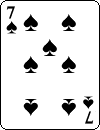
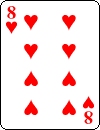
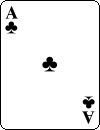
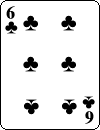 versus
versus 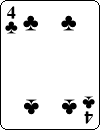

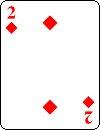
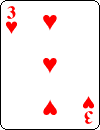
The order of the cards within each group of four is not important. What is of interest is the corresponding signed sums:
1 - 8 + 6 + 7 = 2 + 3 + 5 - 4 (= 6),
and
12 - 82 + 62 + 72 = 22 + 32 + 52 - 42 (= 22).
The first equality allows us to force 6, but it is the second, forcing 22, that we focus on. Assuming that the packet of eight cards initially consists, as above, of a black Ace, 6 and 7, and a red 8, followed by a red 2, 3 and 5, and a black 5, then asking how many black cards the spectator has leads without fail to the third paragraph on page 22 of Peter Winkler's book, as desired.
Add Variants Noted
Above, we concentrated on the ability to force sums of squares. The fact that the sum of the values is also predictable means that all quadratic functions evaluated and summed over {1, 4, 6, 7} (or {2, 3, 5, 8}) yield predetermined answers. This suggests looking at the second central moment (variance) of the values obtained, and its square root, the standard deviation. Since variance(X) = mean[(X - mean(X))2] = mean(X2) - (mean(X))2, here we get ¼ sum(X2) - (¼ sum(X))2. For {1, 4, 6, 7} (or {2, 3, 5, 8}) this yields exactly 5.25, and hence a standard deviation of roughly 2.2913. We have partitioned {1, 2, ..., 8} into subsets of equal size, mean and standard deviation.
You could ask a suitably inclined spectator to have a calculator at the ready, and go through the motions of having four cards picked "at random" from eight presented. This time there would be absolutely no significance to the colours or suits used, just ensure that any Ace, 4, 6 and 7 start off (in any order) at the top of the packet. If you do not draw attention to the eight cards being used, then, the bottom four cards may have arbitrary values, maybe even four Aces for a dramatic finale (start off with a 2, 3, 5 and 8 at the top in that case). In any case, you are now in a position to reveal a prediction slip on which is written "The standard deviation of the four numbers you obtained is about 2.2913." (If you expect the n - 1 version of the standard deviation to be calculated, have 2.6458 written instead.)
The variance lens actually provides some insight as to why the {1, 4, 6, 7} versus {2, 3, 5, 8} partition does preserve sums of squares in addition to sums. If Y denotes {2, 3, 5, 8}, and Z denotes {7, 6, 4, 1}, then Z = 9 - Y, and so variance(Z) = variance(Y), and then sum(Y2) = sum(Z2) follows from the fact that variance(X) = sum(X2) - (sum(X))2.
Slam Row Data
One presentational alternative available, once you have forced the {1, 4, 6, 7} versus {2, 3, 5, 8} split, is to make more use of the resulting balancing act. Announce up front that the purpose of the exercise if to see if the spectator has randomly selected cards of higher value than the ones you are left with. Upon completion of the separation, request that the spectator reveal the total (or average) of his cards. When that is announced, look puzzled and a bit amused as you put your cards on the table, saying, "That's really amazing, I got the same total and average that you did. What are the chances of that happening? I guess it's a draw."
Pause briefly, then say, "Just a moment, what is the total of the squares of your four values?" As everyone can see, your square total also matches the spectator's. "I don't believe it! You know what this means, don't you? You have selected cards with the same mean and standard deviation as the ones you left for me. Statistically speaking, I'd say that was probably very unlikely, but somehow you did it. I'm impressed."
Let that sink in, and then continue, "One more moment, let's try this for a tie-breaker, please tell me what total of cubes you obtained. Here is a calculator to help you, write down your answer here, and then please find the total of my cubes." Since {1, 4, 6, 7} yields cube total 624, and {2, 3, 5, 8} yields 672, you can finally declare victory by a modest margin (the upper 48). "I once heard a statistician say that this game is half skewed in my favour". (Actually, below we briefly discuss the third central moment, which here turns out to be -6 and 6, respectively, and dividing by the cube of the standard deviations yields skewnesses. of about ∓ 0.4988.)
Ace Is Confining
Before moving upwards and onwards, we might ask, what other significance attaches to {1, 4, 6, 7}? Certainly, they are the first four numbers n for which the rank of the elliptic curve y2 = x3 + n is 0. Then there is the undeniable connection with Mrs. Perkins Quilt. We prefer a more innocent explanation: the complementary 2, 3, 5, 8 are part of the standard Fibonacci sequence, and if this sequence is continued and reduced mod 9, as was investigated in the June 2007 Card Colm, then 7, 6, 4, 1 occur exactly twelve terms later. Or maybe we have all of this backwards.
With Nonstandard Total Ties
As Peter Winkler has been trying to tell us from the very beginning, the above can be generalized further: it's possible to partition {1, 2, 3, ..., 16} into subsets of equal size with the same sums, sums of squares and sums of cubes, and hence the same mean, standard deviation and (as we will shortly see) the same skewness also. There are many ways to partition {1, 2, 3, ..., 16} into subsets with equal sums, and several of those have equal sums of squares, for instance {1, 3, 6, 8, 10, 12, 13, 15} and its "natural complement" 17 - {1, 3, 6, 8, 10, 12, 13, 15}, as may be verified by copying the earlier variance argument. However, only the
{1, 4, 6, 7, 10, 11, 13, 16} versus {2, 3, 5, 8, 9, 12, 14, 15}
partition has equal sums of cubes too (Exercise: explain why this split does the trick without resorting to mere computation).
There is a similar partition of {1, 2, 3, ..., 32} which preserves (sums and) sums of squares, sums of cubes and also sums of fourth powers, and hence standard deviation, skewness and also kurtosis. We leave it to interested readers to pursue this for cards.
IndictS-th Union
Winkler, in the book already mentioned, suggests a general "translate and twist" method for building up the desired partition of {1, 2, 3, ..., 2s}; the goal is to find two equal sized subsets with equal sums, sums of squares, sums of cubes, and so on, up to equal sums of (s-1)th powers. First, note that {1, 2, 3, 4} trivially splits into subsets {1, 4} and {2, 3} with equal sums. Next, {1, 2, 3, ..., 8} is the union of {1, 2, 3, 4} and its translation 4 + {1, 2, 3, 4}. Combining that with the equal sum split of {1, 2, 3, 4}, we see that {1, 2, 3, ..., 8} is also the union of {1, 4}, {2, 3}, 4 + {1, 4} and 4 + {2, 3}. A little twist then yields,
{1, 2, 3, ..., 8} = {1, 4} ∪ (4 + {2, 3}) ∪ {2, 3} ∪ (4 + {1, 4}) = {1, 4, 6, 7} ∪ {2, 3, 5, 8}.
This latter split has equal sums of squares (but why?!) as well as equal sums. We can develop this into an induction proof of the general result. To step up to s = 4, start with the above s = 3 case, namely {1, 2, 3, ..., 8} = {1, 4, 6, 7} ∪ {2, 3, 5, 8}, and then translate and twist as follows:
= {1, 4, 6, 7} ∪ (8 + {2, 3, 5, 8}) ∪ {2, 3, 5, 8} ∪ (8+ {1, 4, 6, 7})
= {1, 4, 6, 7, 10, 11, 13, 16} ∪ {2, 3, 5, 8, 9, 12, 14, 15}.
This final split has equal sums (68), square sums (748), and also cube sums (9248). This, in turn, leads to a common variance of 748/8 - (68/8)^2 = 21.25 and hence a common standard deviation of about 4.6098 (the n - 1 version of the latter is about 4.9281). The common third central moment can be computed using the identity:
mean[(X - mean(X))3] = mean(X3) - 3 mean(X2) mean(X) + 2 [mean(X)]3.
For X = {1, 4, 6, 7, 10, 11, 13, 16} as above, we get 9248/8 - 3(748/8)(68/8) + 2 (68/8)3 = 0. This is hardly surprising, the symmetry of X about its mean 8.5 leads one to expect zero skewness.
Even Stake
Values larger than 13 are not conveniently represented by cards, but a simple linear change of variable takes care of that: let y = {1, 4, 6, 7, 10, 11, 13, 16} - 7 = {-6, -3, -1, 0, 3, 4, 6, 9} and z = {2, 3, 5, 8, 9 12, 14, 15} - 7 = {-5, -4, -2, 1, 2, 5, 7, 8}, then y and z have the same sums (12), sums of squares (188) and sums of cubes (792). Since we have merely translated the earlier values, we must obtain the same variance (21.5) and skewness (0). Now, adopting the convention that negative numbers are represented by red cards, and zero by a joker, we can operate with a usual deck of cards. The Bill Simon principle can be extended to work with a packet of sixteen cards, say with 6♥, 3♦, A♦, Joker, 3♣, 4♠, 6♠, 9♣ (in some order) on the top, followed by 5♦, 4♥, 2♦, A♠, 2♠, 5♣, 7♣, 8♠ (in some order), and the spectator is sure to end up with the first eight of these cards. If directed to compute using those values (with red cards and the Joker making negative and zero contributions, respectively), then 12 and 188 (and, if desired, 792 also) may be forced or predicted. Note that this time, the red cards contribute positively to the sums of squares, as we're squaring negative numbers in the usual way.
See Peter Winkler's Fender-Benders page for an interesting lead to more information on the so-called multi-grade equations explored here this time around.
"Plurality Events" is an anagram of "A Truly Even Split." "Binomials Align" is an anagram of "Bill Simon Again" (so is "Boiling Animals"). "Intact Amigo Pair" as an anagram of "A Magic Partition" (so is "Patriot Magician"). "Charged Pair Rapport" is an anagram of "Paragraph Predictor." "Add Variants Noted" -- like "Variants Not Added" -- is an anagram of "Standard Deviation." "Slam Row Data" is an anagram for "Almost A Draw" (so is "A Modal Straw"). "With Nonstandard Total Ties" is an anagram of "Do The Translation and Twist." "Indict S-th Union" is an anagram for "Induction Hints." "Even Stake" is an anagram for "Take Seven." It goes without saying that "Ace Is Confining" is an anagram of "No Significance." For more on mathematical card tricks, including a guide to topics explored in previous Card Colms, see http://www5.spelman.edu/~colm/cards.html.




